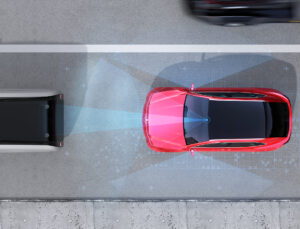
NHTSA finalizes AEB requirement to begin in 2029
By onLegal
The National Highway Traffic Safety Administration (NHTSA) has finalized a new Federal Motor Vehicle Safety Standard (FMVSS) that will make automatic emergency braking (AEB), including pedestrian AEB (PAEB), standard on all passenger cars and light trucks by September 2029.
NHTSA expects the FMVSS No. 127 will significantly reduce rear-end and pedestrian crashes, saving at least 360 lives and preventing at least 24,000 injuries every year. NHTSA also says AEB and pedestrian AEB will significantly reduce crash-related property damage and associated costs.
AEB systems use sensors to detect when a vehicle is close to crashing into a vehicle or pedestrian in front and automatically apply the brakes if the driver doesn’t. PAEB technology detects a pedestrian in both daylight and at night.
In 2022, the Insurance Institute for Highway Safety (IIHS) and the Highway Loss Data Institute (HLDI) petitioned federal regulators to require pedestrian AEB on passenger vehicles that work well in the dark.
At that time, NHTSA had already been directed by the U.S. Department of Transportation to initiate rulemaking on a requirement that new passenger vehicles be equipped with the technology by 2024, but according to IIHS and HLDI, the requirement wouldn’t have included effective PAEB in all light conditions.
The new standard requires all cars to stop and avoid contact with a vehicle in front of them up to 62 miles per hour. The systems must also detect pedestrians in daylight and at night. The standard requires that the AEB system apply the brakes automatically up to 90 mph when a collision with a lead vehicle is imminent, and up to 45 mph when a pedestrian is detected.
“The new vehicle safety standards we finalized today will save hundreds of lives and prevent tens of thousands of injuries every year,” said U.S. Transportation Secretary Pete Buttigieg, in an NHTSA news release. “The Bipartisan Infrastructure Law is not only making historic investments in transportation, it’s also ushering in a new era of safer travel by ensuring new cars and light trucks are equipped with automatic emergency braking, making our roads safer for drivers and pedestrians alike.”
FMVSS No. 127 fulfills a Bipartisan Infrastructure Law provision to establish minimum performance standards that require all passenger vehicles to be equipped with AEB, according to NHTSA. The standard also advances USDOT’s National Roadway Safety Strategy (NRSS), which was launched in January 2022 to address the national crisis in traffic fatalities and serious injuries.
The NRSS adopts a “safe system approach” and builds multiple layers of protection with safer roads, safer people, safer vehicles, safer speeds, and better post-crash care, according to USDOT. As part of the safe system approach, FMVSS No. 127 highlights safer vehicles and USDOT’s effort to expand vehicle systems and features to help prevent crashes, the release states.
The final rule applies to vehicles with a gross weight rating of 10,000 pounds or less, which is nearly all U.S. light vehicles, according to NHTSA.
“Automatic emergency braking is proven to save lives and reduce serious injuries from frontal crashes, and this technology is now mature enough to require it in all new cars and light trucks,” said NHTSA Deputy Administrator Sophie Shulman, in the release. “In fact, this technology is now so advanced that we’re requiring these systems to be even more effective at higher speeds and to detect pedestrians. Most new vehicles already come with AEB, and we expect that many cars and light trucks will be able to meet this standard ahead of the deadline, meaning even more lives will be saved thanks to this technology.”
In June 2023, NHTSA and the Federal Motor Carrier Safety Administration announced a separate notice of proposed rulemaking that would require heavy vehicles, including tractor-trailers, to have AEB, which the agencies are in the process of finalizing, according to the release.
Images
Featured image credit: Chesky_W/iStock
